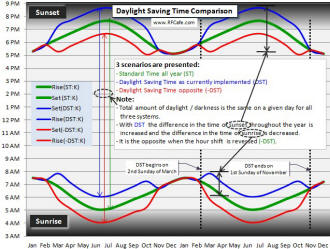
Daylight Saving Time Comparison for Three Variations

Daylight and Darkness vs. Latitude
Daylight Saving Time (DST) ends at 2:00 am local time this coming Sunday morning
in most of the U.S., whereupon we return to Standard Time (ST). The event, as with
the beginning of DST in March, always elicits a lot of debate over whether DST is
necessary in the 21st century. I would prefer to end the inane biannual ritual for
reasons illustrated in the graph I created in Excel*.
Daylight Saving Time is
not observed everywhere across the globe, and where it is observed
there are variations in when it begins and ends. In the U.S., DST begins the second
Sunday of March and ends on the first Sunday in November (which is this coming weekend).
Only Arizona and Hawaii
do not participate.
To begin with, look at the chart titled "Daylight Saving Time Comparison." The
overall amount of daylight and darkness does not change on any given day or any
given location for ST, DST, or -DST, only the clock times of those occurrences.
Two complete years are plotted for three cases:
- Standard Time all year (ST, green line). Note
the time difference between the curve maximum and minimum for comparison to the
other two cases (both for sunrise and for sunset).
- Daylight Saving Time in the manner currently implemented in the U.S., with changeovers
occurring as noted above (DST, blue line); i.e.,
an hour is added on the 2nd Sunday of March and removed on the 1st Sunday of November.
Note that the time difference between the max/min for the clock time of sunset is
much greater than the ST value. Note also that the time difference between the max/min
for the clock time of sunrise is much less than the ST value.
- Daylight Saving Time opposite of the manner currently implemented in the U.S.,
with changeovers occurring as noted above (-DST, red line);
i.e., an hour is subtracted on the 2nd Sunday of March and removed on the 1st Sunday
of November. Note that the variation in amplitudes of sunrise and sunset are reversed.
Personally, I find the amplified differences in the times of sunset because of
DST to be annoying. Swapping to the -DST system (my invention) solves the problem
and reduces the sunset clock time variation throughout the year, but then the clock
time of sunrise exhibits the amplified variations. That situation could prove to
be equally annoying to people who are awake more in the morning hours than in the
evening hours. The blackout curtains on my bedroom windows would effectively mask
the early morning sunlight caused by the -DST system, so I would prefer it over
DST if we must endure a time switch. However, I would much rather prefer that we
dispose of Daylight Saving Time altogether. It simply is not required in the 21st
century.
DST was first implemented in the early 20th century when the U.S. was more of
an agricultural society and the argument was to give farmers more daylight in the
morning when they traditionally performed most chores ... or to conserve energy
in wartimes, depending on
whose account you believe. Congress has adjusted the start and
stop dates multiple times in the last century, and even did away with it for a while,
only to bring it back during the energy crisis in the 1970s. It is time
(pun intended) to do away with it for good.
I created a second chart that does not pertain to Daylight Saving Time, but instead
illustrates how the latitude on which you live affects the amount of daylight and
darkness you experience throughout the year. Sunrise and sunset clock times were
plotted for three widely varying latitudes in the U.S.: Miami, Florida;
Kernersville, North Carolina (where I once lived); and Portland,
Maine. As shown, the nearer to the equator you are located, the less the variation
in day/night throughout the year, and the nearer to the poles you are located, the
more the variation. At the Arctic and Antarctic circles, there is no sunrise on
the winter solstice
and there is no sunset on the summer solstice. At greater latitudes you will experience
the 'midnight
sun' on days surrounding the summer solstice. For a given latitude, changes
in longitude does not affect the amount of daylight and darkness on a given day,
only the clock time at which they occur.
You might also be interested in an article I wrote a couple years later titled,
"Daylight Saving(s) Time vs. Standard Time."
* Data obtained from the the
U.S. Naval Observatory website.
Posted October 31, 2014
|




























